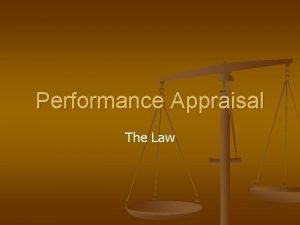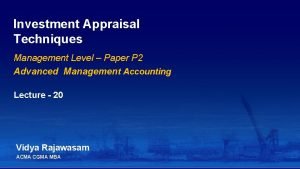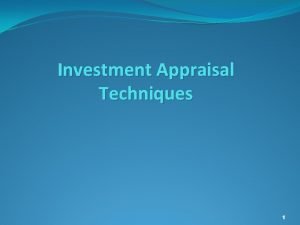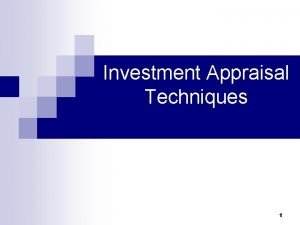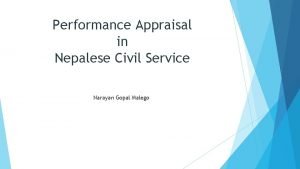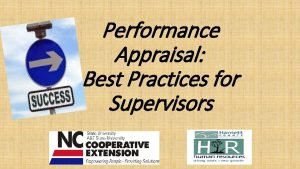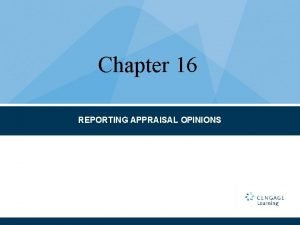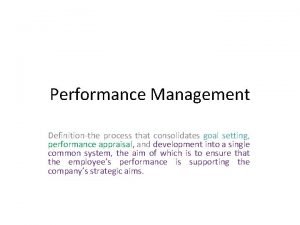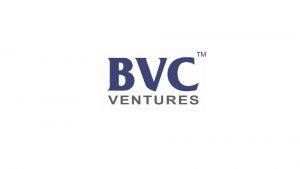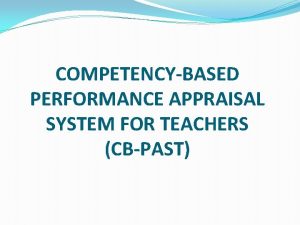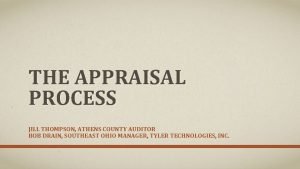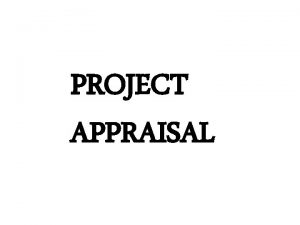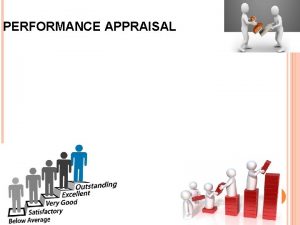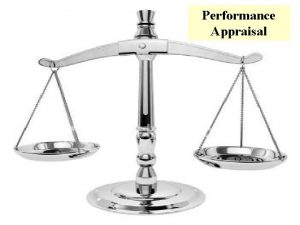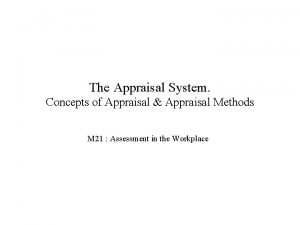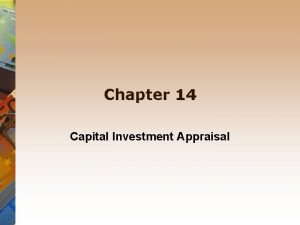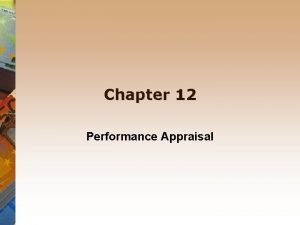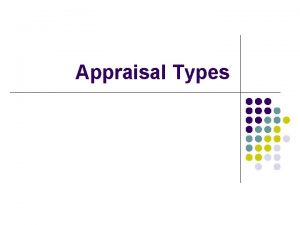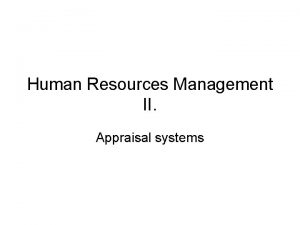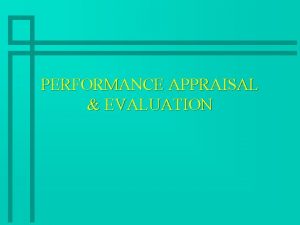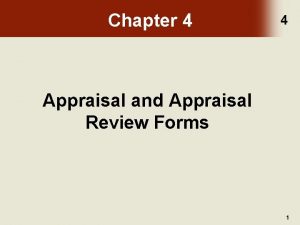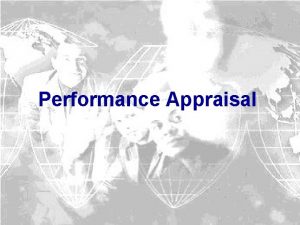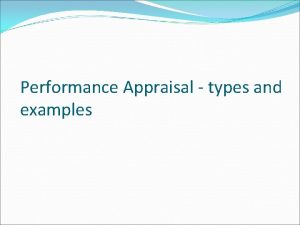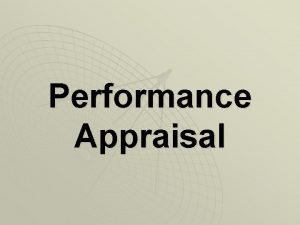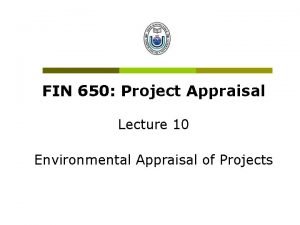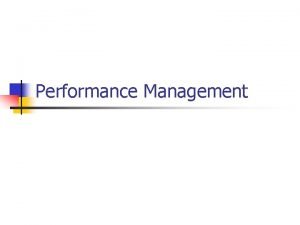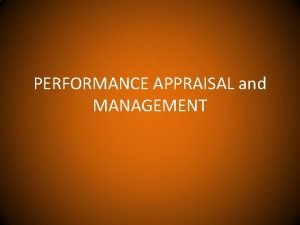Investment Decisionmaking Content Investment Issues with investment appraisal




















- Slides: 20

Investment Decision-making

Content • Investment • Issues with investment appraisal • Investment appraisal techniques: – Payback – Average Rate of Return (ARR) – Discounted cash flow (NPV) • Qualitative factors affecting decisions:

Investment • Investment refers to the purchasing of productive capacity or capital expenditure • Capital expenditure – Spending by a business to buy fixed assets e. g. property, vehicles etc

Why invest? • Businesses need to invest to grown • They might want to increase capacity so they can produce more • If they produce more then they can sell more and increase sales revenue • They could also look to invest to increase the efficiency of their operations

Investment Appraisal • Looks at whether an investment project is worthwhile or not • Can be used for all types of investment from the purchase of a new piece of machinery to a whole factory • It allows managers to make an informed choice regarding the viability of the project

Financial techniques of investment appraisal • These are all based on a number of assumptions: – All costs and revenues can be forecast accurately for future years – Key variables like interest rates will not alter – That the business will be looking to maximise profits

Problems with Forecasts • There may be problems with forecasts because: – Competitors could bring out new products / change prices altering sales and revenue – Tastes and fashions may change causing an unexpected slump in demand – The economy may change either upwardly or downwardly – recession or boom – Costs can be affected by inflation and import prices

Investment Appraisal • Types of investment appraisal: – Payback Period – Accounting Rate of Return (ARR) – Net Present Value (discounted cash flow) – Discounted cash flow

Investment Appraisal • The idea is that if you invest in the future you will have more incomes coming into the business • Investment appraisal methods look at the comparison of the future incomes with the cost of the initial investment

Payback Method • This looks at how long it takes to pay back the initial cost of the investment • Need to know how much revenue the asset will generate • For example if a machine costs £ 50, 000 and it produces items 50, 000 items that retail for 50 p each it will take 2 years to payback the initial investment

Payback method • This allows you to compare projects – which one takes the shortest time to payback the initial investment • It can take an investment less than a year to generate revenues that cover its cost

Advantages and Disadvantages of Payback Advantages • Easy and simple to use and understand • Good if you just want a quick rate of return Disadvantages • Doesn’t look at timings of payments • Doesn’t look at incomes received after payback • Profit isn't calculated

Average Rate of Return • Looks at the profit generated by the investment compared to the cost of the investment Average profit • ARR = ---------------------- x 100 Initial cost of investment • This gives the business a % figure showing the average rate of return • Businesses can then compare this figure to how much they would get with alternative investments

Advantages and Disadvantages of ARR Advantages • Looks at profits • Easy to compare with other methods of investment e. g. putting money in the bank Disadvantages • Only looks at average profits • Doesn’t look at timings of payments

Discounted cash flow • This considers what money will be worth in the future • Discounting – reduce value of future earnings to reflect opportunity cost of an investment • Reasons why this exists: – Risk – Opportunity cost

Net Present Value • One way of discounting cash flow is looking at NPV • This method takes into account inflationary pressures and interest rates • The idea that the money increases in value • Looks at how much you would need to invest now to earn a certain amount in the future • Allows comparison of an investment by valuing all cash inflows from the investment at the present value • You can compare what would happen if you invested the money in other projects or just saved it in the bank

Net Present Value Future Value PV = --------(1 + i)n Where i = interest rate n = number of years • Cash flow x discount factor = present value • Present Values can be found through valuation tables

Discounted cash flow – Advantages and Disadvantages Advantages • Looks at the opportunity cost of investing • Considers cash inflows and outflows for the lifetime of the investment Disadvantages • Can be difficult to choose the right discount rate • Is very complex

Qualitative techniques of investment appraisal • As well as financial methods firms need to consider: – Corporate image – you may reject an investment opportunity as it will reflect badly on your business – Corporate objectives – also have to judge if the investment is aligned to your corporate objectives – Environmental and ethical reasons – is the investment environmentally and ethically sound – Industrial relations – what is the impact on the work force – does it decrease jobs?

Summary • Investment is the process of purchasing fixed assets in order to increase capacity / productivity • Investment appraisal techniques aim to assess the financial feasibility of investment options • Investment appraisal techniques are based on a number of assumptions which may not be true • Payback method looks at how long it will take to pay back the cost of the initial investment • Average rate of return looks at the percentage rate of return on the investment • Discounted cash flow (NPV) looks at the present values of any future revenues from the investment • Qualitative factors affect investment decisions including corporate image, objectives, industrial relations and environmental and ethical reasons
 Survey of household economics and decisionmaking
Survey of household economics and decisionmaking Legal issues in performance appraisal
Legal issues in performance appraisal Investment appraisal examples
Investment appraisal examples Investment appraisal techniques
Investment appraisal techniques Investment appraisal questions
Investment appraisal questions Real content and carrier content in esp
Real content and carrier content in esp Dynamic content vs static content
Dynamic content vs static content Fixed investment and inventory investment
Fixed investment and inventory investment Reflected appraisal
Reflected appraisal Civil service performance appraisal examples
Civil service performance appraisal examples Performance appraisal best practices
Performance appraisal best practices Narrative appraisal report sample
Narrative appraisal report sample Cad grayson county
Cad grayson county Tat in appraisal comments
Tat in appraisal comments Absolute and relative performance appraisal methods
Absolute and relative performance appraisal methods Reflected appraisal
Reflected appraisal Pms appraisal
Pms appraisal Behaviorally anchored rating scale
Behaviorally anchored rating scale Competency-based performance appraisal system for teachers
Competency-based performance appraisal system for teachers Appraisal
Appraisal Cmmi appraisal types
Cmmi appraisal types

